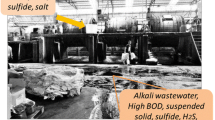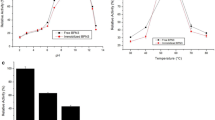Abstract
Proteases with alkaline nature and requisite catalytic characteristics have been the supreme interest of numerous industrial sectors. The present study was focused on justifying the following aims, i.e., (1) protease producing strain improvement via physical and chemical mutagenesis, (2) protease optimization, purification, and immobilization on chitosan beads, and (3) de-staining and goat skin dehairing potentialities of chitosan beads immobilized protease (ChitB-protease). Briefly, a protease produced by a UV mutant Bacillus sp. MS1 was purified and characterized to present its scope for detergent and leather sectors. Two-step purification resulted up to 4.1-fold purification and 41% yield of Bacillus sp. MS1 protease. The purified fraction was identified as a monomeric with an apparent molecular weight of 28 kDa on sodium dodecyl sulfate–polyacrylamide gel electrophoresis. The protease was entrapped in glutaraldehyde-activated chitosan beads to improve its stability and reusability. The ChitB-protease represented the highest activity and immobilization efficiency of 10.31 U/mL and 86.43 ± 1.15%, respectively. ChitB-protease exhibited better catalytic activity in a broader pH range and higher temperature than free enzyme. Moreover, a significant improvement in the thermal resistance was also recorded after immobilization. ChitB-protease retained 70.53% of its initial activity after seven washings. SEM morphological analysis further confirmed the recycling efficiency of ChitB-protease. Furthermore, a complete de-staining and dehairing were observed within the short incubation period. These results suggest that this protease is potentially useful in many industrial applications.
Graphic Abstract











Similar content being viewed by others
References
Altinkaynak C, Tavlasoglu S, Ocsoy I (2016) A new generation approach in enzyme immobilization: organic-inorganic hybrid nanoflowers with enhanced catalytic activity and stability. Enzyme Microb Technol 1(93):105–112
Asgher M, Aslam B, Iqbal HM (2013) Novel catalytic and effluent decolorization functionalities of sol-gel immobilized Pleurotus ostreatus IBL-02 manganese peroxidase produced from bio-processing of wheat straw. Chin J Catal 34(9):1756–1761
Asgher M, Bashir F, Iqbal HM (2018) Protease-based cross-linked enzyme aggregates with improved catalytic stability, silver removal, and dehairing potentials. Int J Biol Macromol 15(118):1247–1256
Beg QK, Saxena RK, Gupta R (2002) De-repression and subsequent induction of protease synthesis by Bacillus mojavensis under fed-batch operations. Process Biochem 37(10):1103–1109
Berthold A, Cremer K, Kreuter JS (1996) Preparation and characterization of chitosan microspheres as drug carrier for prednisolone sodium phosphate as model for anti-inflammatory drugs. J Control Release 39(1):17–25
Betty AF, Daniel FS, Alice SW. Overview of Bacterial Identification Methods and Strategies in Bailey and Scott’s Diagnostic Microbiology (11th Ed. pp. 225–283.) Published by Mosby Inc. USA (2002).
Bhandari S, Gupta VK, Singh H (2009) Enhanced stabilization of mungbean thiol protease immobilized on glutaraldehyde-activated chitosan beads. Biocatal Biotransform 27(1):71–77
Bilal M, Iqbal HM (2019) Chemical, physical, and biological coordination: an interplay between materials and enzymes as potential platforms for immobilization. Coord Chem Rev 1(388):1–23
Bilal M, Iqbal HaM (2019) Tailoring multipurpose biocatalysts via protein engineering approaches: a review. Catal Lett 149(8):2204–2217
Bilal M, Iqbal HM (2021) Armoring bio-catalysis via structural and functional coordination between nanostructured materials and lipases for tailored applications. Int J Biol Macromol 166:818–838
Bilal M, Iqbal HM, Guo S, Hu H, Wang W, Zhang X (2018) State-of-the-art protein engineering approaches using biological macromolecules: a review from immobilization to implementation view point. Int J Biol Macromol 1(108):893–901
Bilal M, Nguyen TA, Iqbal HM (2020) Multifunctional carbon nanotubes and their derived nano-constructs for enzyme immobilization—a paradigm shift in biocatalyst design. Coord Chem Rev 1(422):213475
Bilal M, Zhao Y, Noreen S, Shah SZ, Bharagava RN, Iqbal HM (2019) Modifying bio-catalytic properties of enzymes for efficient biocatalysis: a review from immobilization strategies viewpoint. Biocatal Biotransform 37(3):159–182
Bradford MM (1976) A rapid and sensitive method for the quantitation of microgram quantities of protein utilizing the principle of protein-dye binding. Anal Biochem 72(1–2):248–254
Corîci LN, Frissen AE, van Zoelen DJ, Eggen IF, Peter F, Davidescu CM, Boeriu CG (2011) Sol–gel immobilization of Alcalase from Bacillus licheniformis for application in the synthesis of C-terminal peptide amides. J Mol Catal B Enzym 73(1–4):90–97
dos Santos Aguilar JG, Sato HH (2018) Microbial proteases: production and application in obtaining protein hydrolysates. Food Res Int 1(103):253–262
Dos Santos JC, Bonazza HL, de Matos LJ, Carneiro EA, Barbosa O, Fernandez-Lafuente R, Gonçalves LR, de Sant’Ana HB, Santiago-Aguiar RS. Immobilization of CALB on activated chitosan: Application to enzymatic synthesis in supercritical and near-critical carbon dioxide. Biotechnology Reports. 2017 Mar 1;14:16–26.
Gupta R, Beg Q, Lorenz P (2002) Bacterial alkaline proteases: molecular approaches and industrial applications. Appl Microbiol Biotechnol 59(1):15–32
El Hadj-Ali N, Agrebi R, Ghorbel-Frikha B, Sellami-Kamoun A, Kanoun S, Nasri M (2007) Biochemical and molecular characterization of a detergent stable alkaline serine-protease from a newly isolated Bacillus licheniformis NH1. Enzyme Microb Technol 40(4):515–523
Haq IU, Nawaz A, Mukhtar H, Mansoor Z, Riaz M, Ahmed M, Ameer SM (2014) Random mutagenesis of Aspergillus niger and process optimization for enhanced production of glucose oxidase. Pak J Bot 46(3):1109–1114
Hussain F, Arana-Peña S, Morellon-Sterling R, Barbosa O, Ait Braham S, Kamal S, Fernandez-Lafuente R (2018) Further stabilization of alcalase immobilized on glyoxyl supports: amination plus modification with glutaraldehyde. Molecules 23(12):3188
Hussain F, Kamal S, Rehman S, Azeem M, Bibi I, Ahmed T, Iqbal HM (2017) Alkaline protease production using response surface methodology, characterization and industrial exploitation of alkaline protease of Bacillus subtilis sp. Catal Lett 147(5):1204–1213
Ibrahim AS, Al-Salamah AA, El-Toni AM, Almaary KS, El-Tayeb MA, Elbadawi YB, Antranikian G (2016) Enhancement of alkaline protease activity and stability via covalent immobilization onto hollow core-mesoporous shell silica nanospheres. Int J Mol Sci 17(2):184
Jellouli K, Ghorbel-Bellaaj O, Ayed HB, Manni L, Agrebi R, Nasri M (2011) Alkaline-protease from Bacillus licheniformis MP1: purification, characterization and potential application as a detergent additive and for shrimp waste deproteinization. Process Biochem 46(6):1248–1256
Kandasamy S, Muthusamy G, Balakrishnan S, Duraisamy S, Thangasamy S, Seralathan KK, Chinnappan S (2016) Optimization of protease production from surface-modified coffee pulp waste and corncobs using Bacillus sp. by SSF. 3 Biotech 6(2):1–1
Karn N, Karn SK (2014) Evaluation and characterization of protease production by Bacillus sp. Induced By UV-Mutagenesis. Enz Eng 3(119):2
Khanam R, Prasuna RG (2013) Strain improvement of Trametes hirsuta by physical and chemical mutagenesis for better laccases production. J Environ Sci Eng 55(3):388–396
Krajewska B (2005) Membrane-based processes performed with use of chitin/chitosan materials. Sep Purif Technol 41(3):305–312
Mateo C, Palomo JM, Fernandez-Lorente G, Guisan JM, Fernandez-Lafuente R (2007) Improvement of enzyme activity, stability and selectivity via immobilization techniques. Enzyme Microb Technol 40(6):1451–1463
Narwal RK, Bhushan B, Pal A, Malhotra SP, Kumar S, Saharan V (2016) Inactivation thermodynamics and iso-kinetic profiling for evaluating operational suitability of milk clotting enzyme immobilized in composite polymer matrix. Int J Biol Macromol 1(91):317–328
Mehdi WA, Mehde AA, Özacar M, Özacar Z (2018) Characterization and immobilization of protease and lipase on chitin-starch material as a novel matrix. Int J Biol Macromol 1(117):947–958
Parra-Saldivar R, Ramirez-Mendoza RA, Sharma A, Oza G, Zavala-Yoe R, Iqbal HM. Robust enzymes designing for efficient biocatalysis. In Biomass, Biofuels, Biochemicals 2020;pp. 49–63. Elsevier.
Pinto UM, Costa ED, Mantovani HC, Vanetti MC (2010) The proteolytic activity of Pseudomonas fluorescens 07A isolated from milk is not regulated by quorum sensing signals. Braz J Microbiol 41(1):91–96
Qamar SA, Asgher M, Bilal M (2020) Immobilization of alkaline protease from Bacillus brevis using Ca-alginate entrapment strategy for improved catalytic stability, silver recovery, and dehairing potentialities. Catal Lett 150:3572–3583
Ranjbakhsh E, Bordbar AK, Abbasi M, Khosropour AR, Shams E (2012) Enhancement of stability and catalytic activity of immobilized lipase on silica-coated modified magnetite nanoparticles. Chem Eng J 1(179):272–276
Rehman S, Bhatti HN, Bilal M, Asgher M (2016) Cross-linked enzyme aggregates (CLEAs) of Pencilluim notatum lipase enzyme with improved activity, stability and reusability characteristics. Int J Biol Macromol 1(91):1161–1169
Sheldon RA (2007) Enzyme immobilization: the quest for optimum performance. Adv Synth Catal 349(8–9):1289–1307
Sheldon RA, van Pelt S (2013) Enzyme immobilisation in biocatalysis: why, what and how. Chem Soc Rev 42(15):6223–6235
Silva C, Martins M, Jing S, Fu J, Cavaco-Paulo A (2018) Practical insights on enzyme stabilization. Crit Rev Biotechnol 38(3):335–350
Singh AN, Singh S, Suthar N, Dubey VK (2011) Glutaraldehyde-activated chitosan matrix for immobilization of a novel cysteine protease, procerain B. J Agric Food Chem 59(11):6256–6262
Singh RK, Tiwari MK, Singh R, Lee JK (2013) From protein engineering to immobilization: promising strategies for the upgrade of industrial enzymes. Int J Mol Sci 14(1):1232–1277
Sivasubramanian S, Manohar BM, Puvanakrishnan R (2008) Mechanism of enzymatic dehairing of skins using a bacterial alkaline protease. Chemosphere 70(6):1025–1034
Tavano OL (2013) Protein hydrolysis using proteases: An important tool for food biotechnology. J Mol Catal B Enzym 1(90):1–1
Tavano OL, Berenguer-Murcia A, Secundo F, Fernandez-Lafuente R (2018) Biotechnological applications of proteases in food technology. Comprehens Rev Food Sci Food Saf 17(2):412–436
Thanikaivelan P, Rao JR, Nair BU, Ramasami T (2004) Progress and recent trends in biotechnological methods for leather processing. Trends Biotechnol 22(4):181–188
Acknowledgments
Thanks to GCUF for the GCUF Research grant program, Project No. 15-ACH-15, and HEC for HEC Project NO. 9512/Punjab/NRPU/R&D/HEC/2017. Consejo Nacional de Ciencia y Tecnología (CONACYT) is thankfully acknowledged for partially supporting this work under Sistema Nacional de Investigadores (SNI) program awarded to Hafiz M.N. Iqbal (CVU: 735340).
Author information
Authors and Affiliations
Corresponding authors
Ethics declarations
Conflict of interest
The authors declare no conflict of interest.
Additional information
Publisher's Note
Springer Nature remains neutral with regard to jurisdictional claims in published maps and institutional affiliations.
Supplementary Information
Below is the link to the electronic supplementary material.
Rights and permissions
About this article
Cite this article
Kamal, S., Hussain, F., Bibi, I. et al. Mutagenesis and Immobilization of ChitB-Protease for Induced De-staining and Goat Skin Dehairing Potentialities. Catal Lett 152, 12–27 (2022). https://doi.org/10.1007/s10562-021-03605-9
Received:
Accepted:
Published:
Issue Date:
DOI: https://doi.org/10.1007/s10562-021-03605-9




